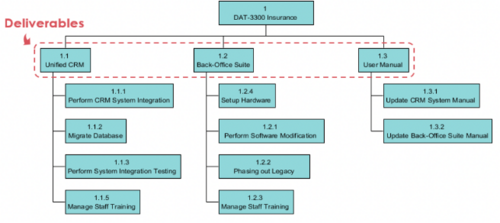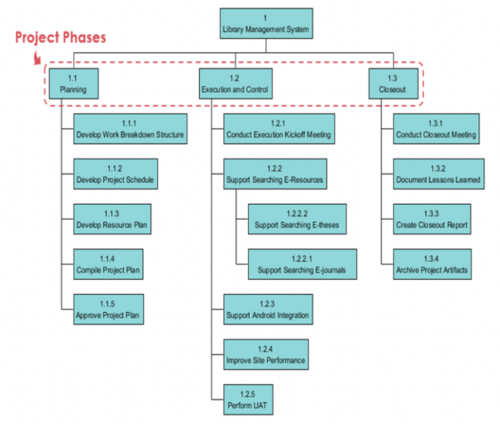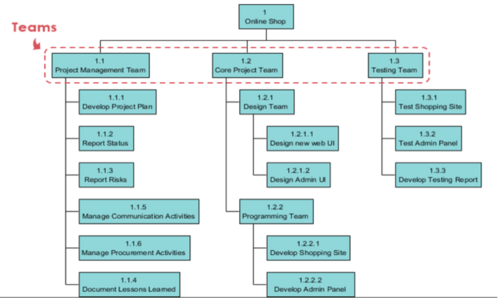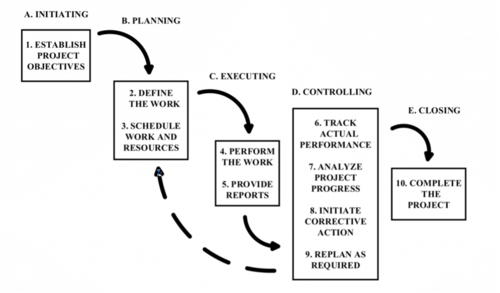Work Break Down Structure(WBS)
"Developed by Qian Xiao“
Contents |
Abstract
Work break down structure is a project management tool that breaking down complex project into phases, deliverables and work packages. A WBS can integrate scope, cost and deliverables into a single tool and provides the necessary framework for detailed cost estimating and control along with providing guidance for schedule development and control. The following article aims to provide an overview of the basic concepts of WBS, the preparation of creating a WBS, and discussing the three different use cases with WBS, finally analysis the limitations of using WBS.
Introductions of WBS
Work break down structure (WBS) is defined as: "Deliverable oriented hierarchical decomposition of the work to be executed by the project time to accomplish the project objectives and create the required deliverables.” by the Project Management Institute (PMI). For project, it is one of the most important project management tools that integrates scope, cost and schedule baselines ensuring that project plans are in alignment. And the project can be planned, executed, controlled, monitored, and reported effectively with this tool.
Elements of WBS
Work break down structure is made up of three elements, which are work, breakdown and structure.
- Work: tasks that can produce tangible results;
- Breakdown: a hierarchical structure of progressive subdivision and classification;
- Structure: organization of the sections according to a certain pattern.
Types of WBS
Here are three main types of WBS: 1) Deliverable-Based, 2) Phase-Based and 3) Responsibility-Based. And the main difference between the two approaches are the elements identified in the first level of WBS.
- A deliverable-based work breakdown structure clearly demonstrates the relationship between the project deliverables (i.e., products, services, or results) and the scope (i.e., work to be executed). From figure 1(a), the level 1 elements are summary deliverable descriptions, while level 2 elements in each leg of the WBS are all the unique deliverables required to create the respective level 1 deliverable.
- A phase-based WBS clearly demonstrates the process of a project. From figure 1 (b), each element of level 1 is typical phases of a project, while the level 2 elements are the unique deliverables in each phase. This kind of WBS type requires work associated with multiple elements be divided into the work unique to each level 1 element.
- A responsibility- based WBS clearly defines project activities based on the organization units that will work on the project. This structure allows the responsibilities involved in the project management process to be assigned to each member.
Features of WBS
The WBS represents a specific description of the project deliverables and scope. It is not a statement of how or when the deliverables will be produced, but rather a refinement and description of the project outputs and scope. It has the following features:
- Supporting the definition of all work required to achieve outputs, objectives, deliverables, or specific outcomes.
- The hierarchical structure used to describe and define the deliverables, and which is established in a “parent-child” relationship.
- Having an objective or specific result, which is known as a deliverable or output.
Importance of WBS
In the execution of the project, there will be found a variety of problems that will lead to disadvantageous impacts on the project target. Many factors lead to several project stumbling blocks, such as over budget, delayed projects, poor quality, and rework. These problems affect the project objectives of cost, quality, and time of project[3]. A constructed WBS can result in the following outcomes:
- Clear work assignments, goals, objectives, and deliverables.
- Scope can be fixed and manageable.
- Budget can be under control.
- Deadline can be meet.
Preparation methods of creating a WBS
When creating a WBS, here are several methods that can be used for creating a WBS. These included outlines and organization charts, fishbone, and brainstorming techniques, top-down and bottom-up development strategies. And WBS templates are available and corporate guidelines or standards can be referenced or copied for quick-starting WBS development[6].
It should be based on the specific project aim, requirements, assumptions, and constraints to choose an appropriate method. The following table highlights some advantages and disadvantages of the above-mentioned methods.
| WBS creation method | Advantages | Challenges |
| Top-down |
|
|
| Bottom up |
|
|
| WBS standards |
|
|
| WBS template |
|
|
When developing the WBS, the project management team first needs to decide which development method to use. The choice of a top-down or bottom-up approach is to some extent a personal choice and may depend on the habits and mindset of the project team, as well as organizational practices. In addition to these considerations, some guidelines and explanations as to which approach may be more appropriate.
Top-down: Use a top-down approach in these situations
Project managers and project management teams have little to no experience in developing WBS. Top-down development allows for a step-by-step understanding and elaboration of the WBS.
The nature of the project's product or service is not well understood. When the scope and nature of the project is not clear, a top-down approach to developing the WBS with all stakeholders helps to gain understanding and consensus. The nature of the project lifecycle is unfamiliar or not well understood. Top-down development of the WBS is more likely to identify lifecycle issues and characteristics. There is no appropriate WBS template available. When developing a WBS "from the ground up", it is much easier to start with the overall project deliverables, such as building a bicycle, and then iterate to identify sub-elements.
Bottom-up: A bottom-up approach is used in these situations
The nature of the project's product or service is well understood. For example, if the organization has developed a very similar product or service in a previous project, the project team may already have a very good understanding of all the interim deliverables required for the new project. The nature of the project lifecycle is well known, and if the organization always uses the same project lifecycle, then the interim deliverables for that lifecycle are well known and can be used to begin bottom-up WBS development. There are appropriate WBS templates. If the organization has WBSs from similar product or service projects and these WBSs can be reused, then the bottom-up approach is the same.
WBS standards and templates
In general, if WBS standards or WBS templates are available, they should be used. There are many samples WBSs in the literature, but care must be taken when choosing to use a sample WBS as a template. Organizations can have WBS templates for very similar projects and are highly encouraged to use these templates. However, if the project is very different from other projects in the organization and no template seems applicable, then develop the WBS "from scratch" using a top-down approach. Regardless of the method chosen to prepare the WBS, the resulting WBS must have all the core characteristics of a high-quality WBS. the WBS must describe 100% of the project's work, must be oriented toward deliverables rather than activities, and must be hierarchically arranged.
Application of WBS
The WBS in the project management
The process of project management with WBS
Project management is a continue process. It focuses on achieving the project objectives within the project management triad of performance, constraints and goals[2]. Here are five types of activities included in the project management process: initiation, planning, execution, controlling and closing (see figure 3.1). This illustration emphasizes the importance of planning before extensive project work and the importance of bringing the project to closure once all the work done.
The WBS is a critical element in the planning and execution of a successful project. Many projects cost, schedule, and quality failures can be traced directly to flaws in the development of the project’s WBS. It is highly unlikely that a project will be successful without the existence of a quality WBS. In contrast, developing and applying a quality WBS will significantly increase the likelihood of successful project completion.
| Process | Importance of WBS in process |
| Initiating |
Historical WBS elements can contribute in determining the scope and viability of projects. |
| Planning |
|
| Executing: the WBS provides the basis for developing the communications plan and the level of granularity at which project information can be distributed. the WBS helps determine what level of project detail is appropriate to communicate to different stakeholders groups. | |
| Controlling |
|
Annotated Bibliography
Project Management Institute. “A Guide to the Project Management Body of Knowledge (PMBOK® Guide)”- Sixth Edition, 2017 The PMBOK Guide is the guide to Body Of Knowledge within Project management, providing widely accepted standards and guide in the use of them. It covers most aspects within project management, although PMI, the publisher, realizes that no book can contain the whole Body of knowledge. This comes clear when the reader looks for motivation in a team, or goal setting techniques. Still, the PMBOK recognizes the importance of both.
References
Cite error: Closing </ref> missing for <ref> tag



